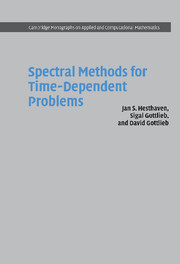Book contents
- Frontmatter
- Contents
- Introduction
- 1 From local to global approximation
- 2 Trigonometric polynomial approximation
- 3 Fourier spectral methods
- 4 Orthogonal polynomials
- 5 Polynomial expansions
- 6 Polynomial approximation theory for smooth functions
- 7 Polynomial spectral methods
- 8 Stability of polynomial spectral methods
- 9 Spectral methods for nonsmooth problems
- 10 Discrete stability and time integration
- 11 Computational aspects
- 12 Spectral methods on general grids
- Appendix A Elements of convergence theory
- Appendix B A zoo of polynomials
- Bibliography
- Index
1 - From local to global approximation
Published online by Cambridge University Press: 04 December 2009
- Frontmatter
- Contents
- Introduction
- 1 From local to global approximation
- 2 Trigonometric polynomial approximation
- 3 Fourier spectral methods
- 4 Orthogonal polynomials
- 5 Polynomial expansions
- 6 Polynomial approximation theory for smooth functions
- 7 Polynomial spectral methods
- 8 Stability of polynomial spectral methods
- 9 Spectral methods for nonsmooth problems
- 10 Discrete stability and time integration
- 11 Computational aspects
- 12 Spectral methods on general grids
- Appendix A Elements of convergence theory
- Appendix B A zoo of polynomials
- Bibliography
- Index
Summary
Spectral methods are global methods, where the computation at any given point depends not only on information at neighboring points, but on information from the entire domain. To understand the idea of a global method, we begin by considering local methods, and present the global Fourier method as a limit of local finite difference approximations of increasing orders of accuracy. We will introduce phase error analysis, and using this tool we will show the merits of high-order methods, and in particular, their limit: the Fourier method. The phase error analysis leads to the conclusion that high-order methods are beneficial for problems requiring well resolved fine details of the solution or long time integrations.
Finite difference methods are obtained by approximating a function u(x) by a local polynomial interpolant. The derivatives of u(x) are then approximated by differentiating this local polynomial. In this context, local refers to the use of nearby grid points to approximate the function or its derivative at a given point.
For slowly varying functions, the use of local polynomial interpolants based on a small number of interpolating grid points is very reasonable. Indeed, it seems to make little sense to include function values far away from the point of interest in approximating the derivative. However, using low-degree local polynomials to approximate solutions containing very significant spatial or temporal variation requires a very fine grid in order to accurately resolve the function. Clearly, the use of fine grids requires significant computational resources in simulations of interest to science and engineering. In the face of such limitations we seek alternative schemes that will allow coarser grids, and therefore fewer computational resources.
- Type
- Chapter
- Information
- Spectral Methods for Time-Dependent Problems , pp. 5 - 18Publisher: Cambridge University PressPrint publication year: 2007

